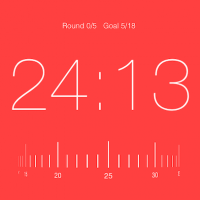The humble timer is arguably one of the simplest, most effective tools to keep us time-focused.
In the context of work or study, setting a timer…
- Provides a sense of urgency.
- Helps us work through the noise of everything else screaming for attention.
- Gives us a deadline.
- Quickens our pace to get things done.
- Helps us avoid time traps.
The timer is hardly new. I’ve certainly used them for years and am sure you have, too.
I have fond memories of a parking timer keychain during my university days. This was of course back in the day, well before all our modern-day gadgets and smart phones. Some of you are wondering if there ever was such a time, a parallel universe perhaps.
I never used it as a parking timer. Didn’t need to. But I found it useful as a timer for my study sessions. I’d set it an hour or two at a time, and continue re-settting it non-stop for seemingly hours on end. Didn’t work so well on the nap breaks, as I recall.
That little timer definitely helped, but it could have been better. Rather, I could have used it better …If only I’d known about the “Pomodoro Technique®” back then!
A technique for the timer.
The creator, Francesco Cirillo, had similarly used a timer – a kitchen timer in the shape of a tomato – to help him with his study habits. But he was more methodical in his work-to-break ratios, and developed the technique that’s become quite popular today. Check out the official site here for more information: Pomodoro Technique.
In essence, the idea is to set a timer and work concentratedly on a given task for a burst of 25 minutes, followed by a 5-minute break of disconnected, non-work activity. A round of this cycle constitutes a ‘pomodoro®’ and at the end of 4 rounds, you take a longer 25-minute break. Then resume another 4 rounds, and so on.
Some benefits, to name a few:
- Frequent breaks help us work longer without burnout, and without dipping into energy stores.
- It’s easier to focus and get more done during segmented bursts of work.
- The combination of work-to-rest ratio pays dividends in productivity.
- It’s easier to track progress and efficiency with measured intervals.
Of course we must actually follow the method to reap the benefits. But it’s much easier to stay on course with a simple tool to help, and that’s where the timer is so effective.
A timer for the technique.
Looking back on those marathon study sessions, I can see where Francesco’s technique could have made an improved difference in how I studied with my beloved parking timer. Surely more intermittent breaks could have kept me going longer without the need to crash out for several hours at a time.
But just as a technique could have upgraded my study experience, the right timer could’ve also enhanced the technique.
Fast forward to today, and now we have best of both worlds: a practical, effective work / study method, with a choice of timer apps that support it.
Personally I use Focus Keeper : Work & Study Timer for iPhone.
The timer performs the task of keeping the work-break sequences (literally) ticking over, so all you have to do is follow the timer.
There are several out there for iOS, Android, Windows, etc. Have a browse and try out a few to see what works best for you.
Of course, if you’re tactile and prefer the feel and function of a kitchen timer, by all means use one …in fact, you can purchase an official pomodoro timer on the Pomodoro Technique website.
More than a timer.
“Do I really need an app for this?”
You may argue that a basic timer will do, but consider how a few extra features on an app can make a difference:
- Pre-set, uniform time blocks. You won’t have to worry about keeping track of work-time intervals versus break-time, or which round you’re on. It’s all programmed in advance.
- Tap once. Start the app and it will tick away hands-free, alerting you when to stop for breaks and when to get back to work. No constant re-setting.
- It’s customisable. Set the time durations as you prefer for work-time, as well as short- and long-breaks. You can adjust if necessary while the app runs. Also, assign different screen colours and sound effects to distinguish between work and rest.
- Visual cues. At a glance, the screen colour lets you know if you’re on a work segment or a short or long break. The countdown keeps you focused and present on time remaining.
- Audio cues. There’s a variety of background sounds, from ‘wall clock’ ticking, to ‘cafe’ chatter, to ‘beach’ waves that help encourage focused work, or detached break. They can be muted, but I find them helpful.
- Time awareness. Time and again I find it fascinating how little time is needed for some tasks, and the reverse for others. The switching from work-to-break-to-work keeps you aware of the passage of time, and highlights what you’re realistically able to achieve.
Your turn.
- Review your current work-break ratio. Could it improve?
- Determine a suitable work-break ratio to follow. It doesn’t have to be 25-5-25. I set my timer app for 50 minutes work, 10 minutes short break, 30 minutes long break. Find what works for you.
- With time and task ready, set your timer or timer app. Or try one if you don’t use one already.
- Focus on your work, honour the breaks, and get more done!
Do you follow another technique, or use a different productivity tool to help?
I’d love to hear what you do, please share!


Comments are closed.